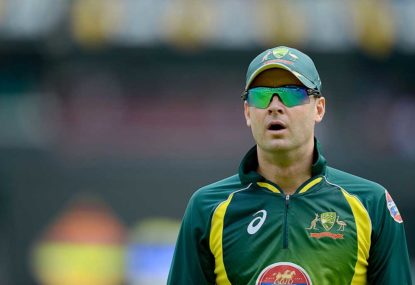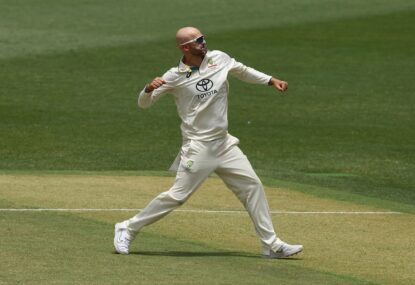Goodness, but this is getting tiresome. The news that an Indian billionaire is planning to lure cricketing stars to a rebel organisation brings on a depressing bout of deja vu.
It seems that cricket has been doomed throughout its history to periodic bouts of rebelliousness amongst its wealthier devotees, and it never augurs well when we hear of another mogul wishing to flex his muscles.
There were rebels even in the early days of international cricket: champion Australian batsman Clem Hill was famous for his habit of punching selectors in the face, and the great WG Grace himself was known to have a nose for money that even his freakishly enormous beard could not hide.
In later years, of course, the most prominent rebel cricketing movement was World Series Cricket [WSC], a concept devised by Kerry Packer as a way of filling the spare airtime on Channel Nine caused by the fact The Big Bang Theory hadn’t started yet.
Many people believed that WSC was a positive development for cricket, as it gave players greater power and allowed them a fair share of the game’s earnings. However, against this must be set the undeniable facts that it also led to: a) a terrible theme song; b) West Indians wearing pink uniforms; and c) a catastrophic saturation of the market for Packer-themed mini-series. If it was a victory, it was hardly a bloodless one.
Then there were the South African rebel tours of the 1980s, which you will remember from the seminal chronicle of cricketing upheaval “Dean Jones: One Day Magic”.
These tours, flouting the sanctions placed on South African sport due to the country’s abhorrent apartheid regime, may have helped sustain top-level cricket in the isolated nation, but also split cricketing communities, set player against player, and cost Australia the period of Trevor Hohns-led world dominance that would have been an inevitability in the mid-1980s were it not for the lure of the rand.
And let’s not even delve into the dreadful matter of Allen Stanford’s Twenty20 tournament, which has been ruled by independent investigators to have all been a dream.
So here we are. Mr Subhash Chandra, having failed to break the establishment’s grip with his Indian Cricket League, is trying again with his ambitious new plan, having presumably realised that the real key to becoming a global emperor of cricket is getting Michael Clarke to play until he’s 44.
This cannot be allowed to happen. The grand old game must not degenerate into an unseemly, avaricious scrabble for cash, the serene village greens of yore turned into battle-scarred hellscapes of division and greed. What’s more, I don’t think Pup’s back will be able to take it. If we want to save the game we love, and give Clarke’s spine a dignified old age, we must act now. I call on all cricket-loving men and women to come to the aid of the party. Here is my five point plan to right the ship.
1. A more equitable global structure
The dominance of England, Australia, and India – known as the ‘Big Three’ in recognition of the fact there are three of them – has gone too far, and is responsible for much of the current unrest.
The recently settled ICC financial structure, which dictates that the bulk of the game’s profits go to these three countries, and that all cricketing nations outside the Big Three must meet every six months to fight each other with spears while the ICC board cheers and throws fruit at them, needs to be changed.
I suggest a new model, whereby all the money made by world cricket is placed in a global fund, and distributed according to the results of the Channel Nine Viewers’ Verdict.
2. A recalibration of the game’s priorities
There’s no doubt a lot of the tradition and grandeur of cricket is on the wane, due to the all-encompassing creep of Twenty20 and the tyranny of the broadcasters. We need to reaffirm what it is that makes cricket such a beautiful game in the first place. To that end I propose a new international schedule: Twenty20 cricket to be confined to three weeks in late July, and for the other 49 weeks of the year every country plays at least one Test match a week.
This model can be tested for five years and if it proves impractical in any way, we can move to Plan B, which I call the ‘It’s Always The Ashes’ model.
3. Better balance between bat and ball
It seems as if the fight to restrict the power of big hitters has been lost – efforts to prevent the growth in bat size have been fruitless, and administrators seem determined to keep bringing in the boundary ropes. But we can still redress the imbalance between power hitters and hapless bowlers, by enhancing the arsenal at the bowler’s disposal.
Under my new rules, for every 100 grams over a kilo that a batsman’s bat weighs, the bowler is allowed one extra stump to aim at. Also, while the ‘free hit’ following a no-ball will stay in place, it will be accompanied by a rule that every time a batsman plays and misses, he must face the next delivery with a spider inside his shirt.
4. More consistency in umpiring
It’s a much-vexed question: how to get more consistency in umpiring decisions, and in particular, how to operate the review system in the best way to maximise correct decisions. Under my plan, there will be no actual changes to the operation of the DRS, but every time a player reviews a decision, a light plane will fly over the ground trailing a banner that reads “IT’S THERE TO ELIMINATE HOWLERS”, just so we never forget.
5. Commentator behaviour moderation
Electroshock and aversion therapy will be utilised on all broadcast commentators, in order that they grow to associate pain and suffering with the terms ‘lost his shape’, ‘bowls a heavy ball’, and ‘good cherry’. The Chappell Institute will be set up to provide support and counselling for those recovering from employment at Channel Nine.
Let’s stave off this revolution and return cricket to that former glory of the days of Bradman, Miller, Lindwall and Wellham. There was a golden age once. There can be again.






































































































